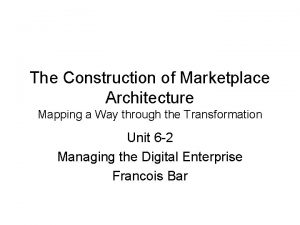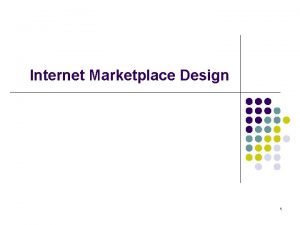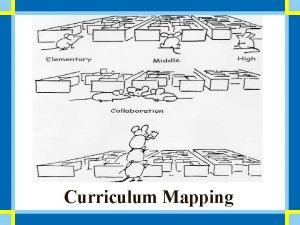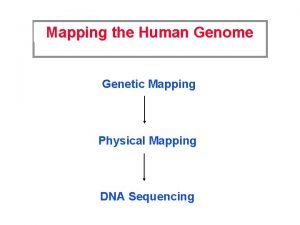The Construction of Marketplace Architecture Mapping a Way










- Slides: 10

The Construction of Marketplace Architecture Mapping a Way through the Transformation Unit 6 -2 Managing the Digital Enterprise Francois Bar


Communication Infrastructure • Commerce requires communication – Buyers and sellers must exchange information about the characteristics of goods and services, about quantities, availability, and prices; firms must coordinate their activities with those of partners and subcontractors • All communication technologies and media have influenced commercial activities – Carrier pigeons and the mails – telegraph and telephone – New communication media

Marketplace • Commercial communications do not take place in a vacuum, but in the context of structured coordination environments within which buyers interact with sellers, negotiate, and agree on the terms of a transaction • These marketplaces come in many shapes and forms, from the vast network of fairs in medieval Europe 13 to the modern NASDAQ • They share the fact that they are embedded within communication infrastructures that shape and constrain their mechanisms: the characteristics of what is traded, the process for matching demand supply depend on the communication infrastructure.

Transaction Mechanisms • These come into play to send, execute, and settle orders (including payments) that have been agreed to in the marketplace • They rely on the features of the communication infrastructure, either to physically transfer a payment or to transmit information about credits and debits to the accounts of buyers and sellers

Deliverables • The system’s goal is to supply deliverables, the service or merchandise being exchanged • The underlying communication infrastructure constrains what goods can be shipped (or transmitted), what services require proximity or can be performed at a distance

Conventional Commerce • In pure conventional commerce, nothing electronic is involved • Buyers and sellers physically meet in a market, communicate face-to-face, conduct transactions directly, and settle them with physical currency • The buyer physically takes delivery of the good or service

Network-Aided Commerce • Network-aided commerce relies on electronic communication technologies to assist traditional commercial activities – The telephone made it possible to conduct traditional transactions at a distance rather than in person, and electronic data interchange (EDI) allowed companies to automate the exchange of orders and invoices • These, however, do not fundamentally change the commercial process, they simply make existing processes faster, cheaper, and more efficient • When a company lets customers pick a product from a website rather than a printed catalog, or takes their orders over e-mail, it uses the Internet as an aid to existing commerce rather than to transform it

Indirect E-commerce • Indirect e-commerce corresponds to the creation of an electronic marketplace on the network, within which demand supply are matched, even though the goods and services traded are ultimately delivered physically to a customer • This matching process often differs significantly from what goes on in the physical marketplaces it replace – SABRE

Direct E-commerce • Direct e-commerce is purely electronic, where the goods or services traded are themselves electronic and delivered over a network – This includes the commerce of software in its many forms, from music to computer programs, as well as online stock exchanges. Insurance and services such as aircraft engine maintenance are now traded that way as well • In this purest form, the electronic infrastructure supports the marketplace and transaction and payment mechanisms as well as the transmission of the traded objects themselves.
 Marketplace software architecture
Marketplace software architecture Memory parameters
Memory parameters Forward mapping vs backward mapping
Forward mapping vs backward mapping Prinsip analisis dan desain
Prinsip analisis dan desain Product architecture mapping
Product architecture mapping One way table and two way table
One way table and two way table Perbedaan one way dan two way anova
Perbedaan one way dan two way anova Advantages of threaded binary tree
Advantages of threaded binary tree Perbedaan two way anova dan one way anova
Perbedaan two way anova dan one way anova One way two way anova
One way two way anova One way anova vs two way anova
One way anova vs two way anova



















